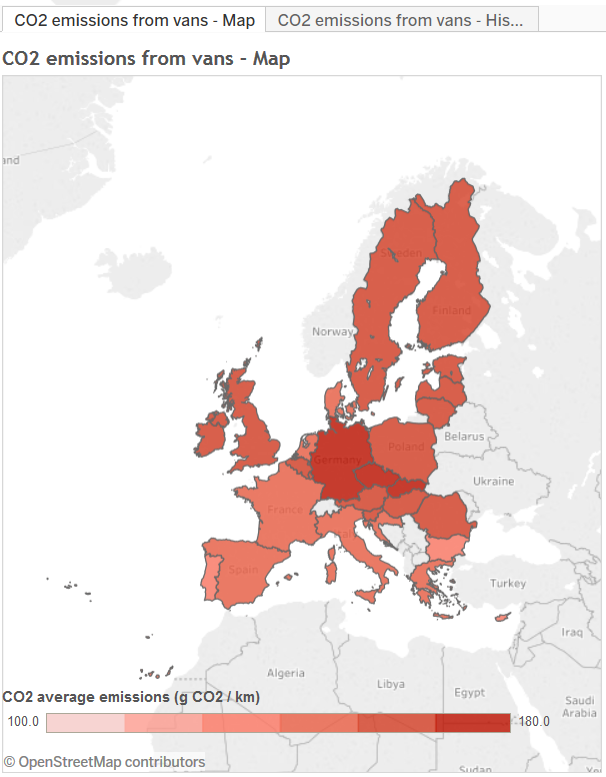The average van registered in the EU in 2017 emitted 156.0 grams of CO2 per kilometre (g CO2/km), which is 7.7 grams less than in 2016. This reduction brings the EU average emissions 10.9% below the 2017 target of 175 g CO2/km. This target was already met in 2013. Further efficiency improvements of 6% are still needed to reach the EU's more stringent target of 147 g CO2/km set for 2020.
Key findings
- In 2017, almost 1.6 million new vans were registered in the EU as in 2016. Higher sales in Sweden (+48%), Czech Republic (+26%) and Slovenia (+20%) were balanced by lower sales in Croatia (-27%), Hungary (-16%), Ireland (-13%), Poland (-12%) and United Kingdom (-10%).
- Two out of three new vans (64%) registered in the EU were sold in just four Member States: the United Kingdom (20%), France (19%), Germany (15%) and Italy (10%).
- The average fuel-efficiency of new vans varied widely across Member States due to the different models and sizes of vehicles sold in each country. As last year, average emissions were lowest in Portugal (133.2 g CO2/km), Cyprus (133.4 g CO2/km) and Bulgaria (134.9 g CO2/km) and highest in the Czech Republic (173.6 g CO2/km), Slovakia (170.1 g CO2/km) and Germany (169.2 g CO2/km).
- The average weight of new vans sold in 2017 also varied across countries. Smaller vehicles were sold in Malta, Cyprus and Portugal (< 1 570 kg); larger vehicles (>1 950 kg) in Slovakia, Czech Republic and Finland.
- There is now an increasing number of electric and plug-in hybrid van models available on the EU market. Registrations of such vehicles increased by 32% in 2017, compared with previous year, representing 0.8% of the total EU van sales. However, this is significantly lower than electric and plug-in hybrid passenger cars' 1.5 % share of total car sales in the same year.
- Diesel vehicles continue to make up the vast majority of the new van fleet, constituting 96% of sales.

Background
The EEA collects and regularly publish data on new light commercial vehicles registered in Europe, in accordance with Regulation (EU) No 510/2011. The data reported by all Member States in order to evaluate the efficiency of the new vehicle fleet includes information on CO2 emissions and vehicle weight.
It has not yet been confirmed whether different manufacturers have met their own specific annual target for 2017, based on the average weight of the vans they sold. The EEA will publish the final data and the European Commission will confirm manufacturers' individual performances in the autumn.
Testing vehicle emissions
Member States report new vehicles' CO2 emission levels, measured under standardised laboratory conditions, following the requirements of the New European Driving Cycle (NEDC) test procedure. This procedure is designed to allow a comparison of emissions for different manufacturers. However, in recent years it has been widely recognised that the NEDC test procedure, developed in the 1970s, is out-dated and does not necessarily represent real-world driving conditions and emissions due inter alia to a number of flexibilities that have allowed vehicle manufacturers to optimise the conditions under which their vehicles are tested.
The EEA has published a non-technical guide explaining the key reasons for the differences observed between official and real world driving emissions. The 'Worldwide harmonized Light vehicles Test Procedure' (WLTP) has been introduced since September 2017 to decrease the divergence between laboratory test and real world emissions.
Document Actions
Share with others